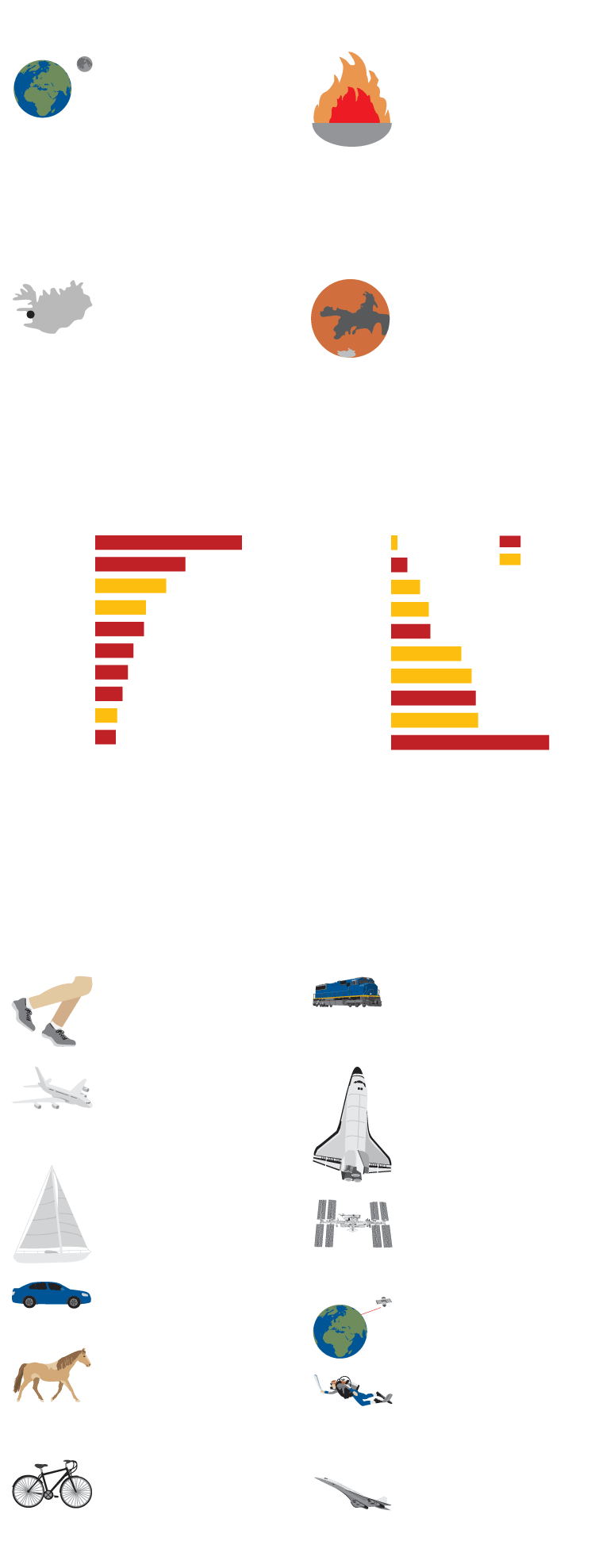Olympic torch relays by the numbers
Alan Hovorka | Story and design
Stacie Kammerling | Illustrations
Alan Hovorka | Story and design
Stacie Kammerling | Illustrations
The almost century-old Olympic torch relay has covered narly half a million miles, changed hands with more than a quarter million people and has been seen by millions more.
This is the Olympic torch relay, by the numbers.

432,000 miles
The torch relay has covered about 432,000 total miles in its 80-year existence.
Someone would need to travel around the earth about 17 times to reach that mileage, with the planet’s circumference being about 24,901 miles.
NASA astronauts will exceed that total mileage on their 2020 trip to the moon. The distance between earth and the moon is about 238,900 miles.
320,000 people
About 320,000 people have served as torchbearers, which is about the same number of people living in Iceland in 2012, according to the World Bank.
The gender distribution of torchbearers is unknown.
Reykjavik, Iceland
5.15 years
The Olympic torch relay has spanned 1,883 days, or 5.15 years, since its inception.
It would take about five years to do two round-trip, manned missions to Mars.
3 relays
Out of all 37 relays, only three of them used flames from places other than Olympia, Greece. The 1952 Oslo Games, 1956 Cortina Games and 1960 Squaw Valley Games. The Oslo and Squaw Valley Games used a Nordic flame lit at Morgedal, Norway. The flame for Cortina was lit at the Temple of Capitoline Jove in Rome.

Ten longest torch relays
The 2016 Rio de Janiero Games represented the sixth longest Olympic Torch Relay in history. The 2008 Games holds the distinction of having the longest relay, where the torch traveled more than 85,000 miles. The chart below details the longest relays, in miles, regardless of transportation. Totals do not account for miles traveled in space.
2008 Beijing
85,128
2004 Athens
52,567
2014 Sochi
41,631
2010 Vancouver
29,316
2000 Sydney
28,681
2016 Rio
23,758
1996 Atlanta
18,029
Summer games
1964 Tokyo
16,196
Winter games
2002 Salt Lake City
13,737
1956 Melbourne
12,719
20,000
40,000
60,000
80,000
100,000
0
Miles traveled
Ten shortest torch relays
The 1952 Oslo Games were the first winter games to feature an Olympic torch relay, which only visited a small part of Norway. These were the same Games that didn’t use a flame from Olympia, Greece. Distances for 1956, 1964 and 1960 were manually calculated using Olympic maps. The chart below details the longest relays, in miles, regardless of transportation.
Summer games
1952 Oslo
139
Winter games
1956 Stockholm
201
1956 Cortina
372
1964 Innsbruck
453
1976 Montreal
481
1960 Squaw Valley
773
1,001
1998 Nagano
1960 Rome
1,157
1976 Innsbruck
1,210
1936 Berlin
1,910
0
500
1000
1500
2000
Miles traveled

Transporting torches
The Olympic torch relay began as a foot relay, traveling from Olympia, Greece, to Berlin. However, politics almost always underscore the Olympics and the Olympic torch relay because of how countries are always trying to one up each other, Olympic historian Philip Barker said.
One area that political creep is visible is in the decision to use different methods of transportation to transport the flame, with countries trying to find most grandiose way to move it.
“Everyone wants to be better than everyone else. That’s why there are these little superlatives each time,” he said.
Every Olympic host wants to make their Olympics the best ever, he said. In part, this is how the torch has made it up into space four times and traveled to the Great Barrier Reef.
These calculations are based on the explicitly mentioned modes of transportation in Olympic reference documents.
37 by foot
Every relay travels by foot, whether its by skis, roller blades, ice skates, runner or a combination of the above.
28 by air
Twenty-eight relays used helicopters, planes and jets to transport the flame. The bulk of these occurred during Winter Olympics. This count includes the use of the concorde jet in 1992.
21 by water
This covers the use of swimming and boats. This total also includes the 2000 Sydney Relay where a scuba diver traveled to the Great Barrier Reef.
12 by vehicle
The relay has used cars, trucks and buses 12 times in 80 years.
6 by horse
The relay first used horses in 1956 during the Cortina and Stockholm relays and wouldn’t do so again until the Munich Games. The most recent relays to feature horseback were during the Atlanta, Sydney and Sochi Games.
4 by bike
Just four relays used bikes to transport the relay, starting with 1968 Grenoble Relay, 1972 Munich Relay and 1976 Montreal Relay. They were last used in the relay for the 1992 Barcelona Games.
3 by train
The torch first traveled by train during the 1996 Atlanta Relay. It used this mode of transportation again in 2014 and 2016.
2 by space shuttle
An unlit torch traveled into space twice onboard a space shuttle, once in 1996 abroad Columbia and again in 2000 abroad Atlantis. The torch has traveled into space four times, two by space shuttle, one by Soyuz and one by satelite.
2 ISS visits
An unlit torch traveled to the International Space Station in 2000 and 2014. Russian cosmonauts took the torch into open space for the first time in 2014.
1 by satelite
In 1976, the flame was transmited by satelite to Montreal, where a laser reignited the flame at the cauldron.
1 by scuba
In 2000, the flame was taken to the Great Barrier Reef near Cairns, Australia. A flare system kept the flame burning underwater. This instance is counted in the “by water” section.
1 by concorde jet
The flame travled aboard a Concorde supersonic jet from Athens, Greece to Albertville, France in 1992. This instance is counted in the “by air” section

3 relays
432,000 miles
Out of all 37 relays, only three of them used flames from places other than Olympia, Greece. The 1952 Oslo Games, 1956 Cortina Games and 1960 Squaw Valley Games. The Oslo and Squaw Valley Games used a Nordic flame lit at Morgedal, Norway. The flame for Cortina was lit at the Temple of Capitoline Jove in Rome.
The torch relay has covered about 432,000 total miles in its 80-year existence.
Someone would need to travel around the earth about 17 times to reach that mileage, with the planet’s circumference being about 24,901 miles.
NASA astronauts will exceed that total mileage on their 2020 trip to the moon. The distance between earth and the moon is about 238,900 miles.
320,000 people
5.15 years
The Olympic torch relay has spanned 1,883 days, or 5.15 years, since its inception.
It would take about five years to do two round-trip, manned missions to Mars.
About 320,000 people have served as torchbearers, which is about the same number of people living in Iceland in 2012, according to the World Bank.
The gender distribution of torchbearers is unknown.
Reykjavik, Iceland
Ten shortest torch relays
Ten longest torch relays
The 1952 Oslo Games were the first winter games to feature an Olympic torch relay, which only visited a small part of Norway. These were the same Games that didn’t use a flame from Olympia, Greece. Distances for 1956, 1964 and 1960 were manually calculated using Olympic maps. The chart below details the longest relays, in miles, regardless of transportation.
The 2016 Rio de Janiero Games represented the sixth longest Olympic Torch Relay in history. The 2008 Games holds the distinction of having the longest relay, where the torch traveled more than 85,000 miles. The chart below details the longest relays, in miles, regardless of transportation. Totals do not account for miles traveled in space.
Summer games
2008 Beijing
85,128
1952 Oslo
139
Winter games
2004 Athens
52,567
1956 Stockholm
201
2014 Sochi
41,631
1956 Cortina
372
2010 Vancouver
29,316
1964 Innsbruck
453
2000 Sydney
28,681
1976 Montreal
481
2016 Rio
23,758
1960 Squaw Valley
773
1996 Atlanta
18,029
1,001
1998 Nagano
1964 Tokyo
16,196
1960 Rome
1,157
2002 Salt Lake City
13,737
1976 Innsbruck
1,210
1956 Melbourne
12,719
1936 Berlin
1,910
20,000
40,000
60,000
80,000
100,000
0
0
500
1000
1500
2000
Miles traveled
Miles traveled
Transporting torches
The Olympic torch relay began as a foot relay, traveling from Olympia, Greece, to Berlin. However, politics almost always underscore the Olympics and the Olympic torch relay because of how countries are always trying to one up each other, Olympic historian Philip Barker said.
One area that political creep is visible is in the decision to use different methods of transportation to transport the flame, with countries trying to find most grandiose way to move it.
“Everyone wants to be better than everyone else. That’s why there are these little superlatives each time,” he said.
Every Olympic host wants to make their Olympics the best ever, he said. In part, this is how the torch has made it up into space four times and traveled to the Great Barrier Reef.
These calculations are based on the explicitly mentioned modes of transportation in Olympic reference documents.
3 by train
37 by foot
The torch first traveled by train during the 1996 Atlanta Relay. It used this mode of transportation again in 2014 and 2016.
Every relay travels by foot, whether its by skis, roller blades, ice skates, runner or a combination of the above.
2 by space shuttle
28 by air
An unlit torch traveled into space twice onboard a space shuttle, once in 1996 abroad Columbia and again in 2000 abroad Atlantis. The torch has traveled into space four times, two by space shuttle, one by Soyuz and one by satelite.
Twenty-eight relays used helicopters, planes and jets to transport the flame. The bulk of these occurred during Winter Olympics. This count includes the use of the concorde jet in 1992.
21 by water
This covers the use of swimming and boats. This total also includes the 2000 Sydney Relay where a scuba diver traveled to the Great Barrier Reef.
2 ISS visits
An unlit torch traveled to the International Space Station in 2000 and 2014. Russian cosmonauts took the torch into open space for the first time in 2014.
12 by vehicle
1 by satelite
The relay has used cars, trucks and buses 12 times in 80 years.
In 1976, the flame was transmited by satelite to Montreal, where a laser reignited the flame at the cauldron.
6 by horse
1 by scuba
The relay first used horses in 1956 during the Cortina and Stockholm relays and wouldn’t do so again until the Munich Games. The most recent relays to feature horseback were during the Atlanta, Sydney and Sochi Games.
In 2000, the flame was taken to the Great Barrier Reef near Cairns, Australia. A flare system kept the flame burning underwater. This instance is counted in the “by water” section.
4 by bike
1 by concorde jet
Just four relays used bikes to transport the relay, starting with 1968 Grenoble Relay, 1972 Munich Relay and 1976 Montreal Relay. They were last used in the relay for the 1992 Barcelona Games.
The flame travled aboard a Concorde supersonic jet from Athens, Greece to Albertville, France in 1992. This instance is counted in the “by air” section